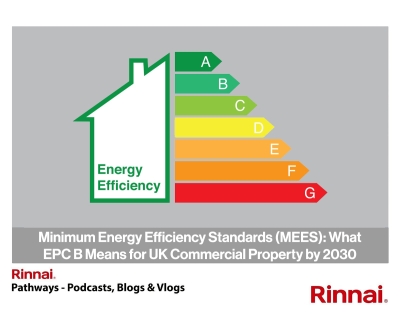The UK’s commercial property sector is facing a seismic shift in energy efficiency regulation. The government’s tightening of the Minimum Energy Efficiency Standards (MEES) means that by 2030, all non-domestic rented buildings must achieve an Energy Performance Certificate (EPC) rating of B or higher to remain legally lettable.
This change will impact landlords, tenants, developers, and facilities managers across the country. With deadlines approaching and compliance costs rising, now is the time to understand what EPC B means and how to prepare.
What Are MEES and EPC Ratings?
MEES regulations were introduced to improve the energy efficiency of buildings in England and Wales. They apply to privately rented commercial properties and are enforced through EPC ratings, which measure a building’s energy performance from A (most efficient) to G (least efficient).
The current MEES requirement is that an EPC rating of E is the legal minimum. As of April 2028, an interim target of EPC C will be introduced and as of April 2030 the final target of EPC B will need to be achieved.
The result of failing to achieve these targets is that buildings cannot be leased, unless they qualify for specific exemptions.
Why Is This Happening?
The UK government is committed to achieving net zero carbon emissions by 2050. Commercial buildings account for a significant portion of energy use and emissions. According to the Climate Change Committee’s Seventh Carbon Budget, emissions from commercial building stock must fall by 87% by 2040 compared to 2023 levels.
To meet this target, half of the reduction must come from low-carbon heating systems and one-third must come from energy efficiency improvements. Raising the MEES threshold to EPC B is a direct way to drive these improvements.
The Scale of the Challenge
The implications are vast. CBRE estimates that 58% of office space in Central London currently falls below EPC B. Across the UK, thousands of commercial buildings are at risk of becoming unlettable unless upgraded.
This includes: offices, retail units, warehouses, hospitality venues, healthcare and education facilities.
What Does EPC B Actually Require?
Achieving an EPC B rating typically will involve the following areas.
- Upgrading insulation in walls, roofs, and floors.
- Replacing inefficient lighting with LED systems.
- Installing smart controls for heating and cooling.
- Improving glazing and window performance.
- Switching to low-carbon heating systems, such as heat pumps or hybrid solutions.
The exact measures depend on the building’s age, use, and existing infrastructure. In some cases, a new EPC assessment using updated methodologies (post-2022) can improve ratings without major capital expenditure.
Cost vs. Value: Why It’s Worth the Investment
While retrofitting can be costly, the long-term benefits are compelling:
- Higher rental yields: Tenants increasingly prefer energy-efficient buildings.
- Reduced operating costs: Lower energy bills and maintenance.
- Future-proofing assets: Avoid obsolescence and regulatory risk.
- Access to green finance: Sustainability-linked loans and grants.
The government is also piloting grant schemes to support upgrades. For example, the West Midlands Combined Authority offers up to £100,000 in match funding for energy efficiency improvements.
Timeline and Uncertainty
While the EPC C by 2028 and EPC B by 2030 targets are widely expected, the government has yet to publish its final response to the 2021 MEES consultation. There is speculation that the EPC B deadline may be pushed slightly beyond 2030, but most experts recommend preparing for the original timeline.
What Should Landlords and Businesses Do Now?
- Audit Your Portfolio: Review EPC ratings across all properties. Commission updated EPCs if assessments are pre-2022.
- Plan Retrofit Strategies: Align upgrades with lease breaks or maintenance cycles. Prioritise cost-effective measures with high impact.
- Engage with Experts: Work with energy consultants and sustainability advisors. Explore funding options and government support.
- Communicate with Tenants: Collaborate on shared goals for energy efficiency. Offer incentives for green fit-outs and smart controls.
How Rinnai UK Can Help
At Rinnai UK, we understand the pressure landlords and developers face. Our low-carbon commercial water heating systems are designed to help buildings meet MEES targets without compromising performance.
We offer:
- Heat pump and hybrid solutions tailored to commercial needs.
- Smart controls and remote monitoring for energy optimisation.
- Technical support and system design aligned with EPC goals.
Whether you're retrofitting a hotel or upgrading a retail unit, our team can help you navigate the path to compliance and unlock long-term value. Contact a Rinnai design expert today for a free consultation.
Final Thoughts
The shift to EPC B by 2030 challenges the commercial property sector to rethink energy use, embrace innovation, and invest in sustainability.
For landlords and businesses that act early, the rewards are clear, better buildings, happier tenants, and a stronger position in a low-carbon future.
